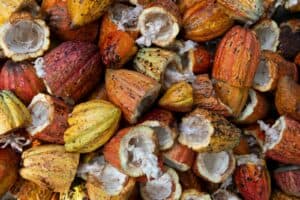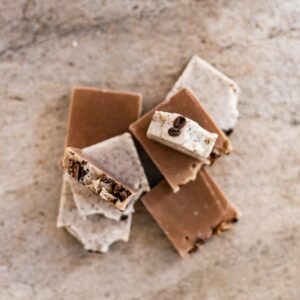Picture a world where chocolate was more than just a delectable indulgence; it was regarded as a potent elixir for health and well-being. In our quest to explore the historical and medicinal mysteries of cacao, we ask the tantalizing question: “Was chocolate ever used as medicine?”
This inquiry leads us on a captivating journey through the annals of history, where cacao beans transcended their role as mere ingredients in chocolate bars to become therapeutic treasures cherished by civilizations from ancient Mesoamerica to the courts of Renaissance Europe. Join us as we unlock the secrets of this luscious “chocolate cure,” tracing its path from sacred rituals to modern-day health benefits, revealing the enduring allure of this sweet ambrosia across the ages.
The Ancient Roots of Chocolate Medicine

Theobroma Cacao: The Chocolate Tree
The story of chocolate as medicine begins with Theobroma cacao, the scientific name for the chocolate tree. This fascinating tree was native to the rainforests of Central and South America, and its name, “Theobroma,” literally means “food of the gods.” Indigenous people in these regions not only consumed cacao but also recognized its medicinal properties. Cacao beans were ground into a paste and used in various medicinal concoctions. These early uses of cacao highlight the deep-rooted cultural significance of chocolate in the region.
Cacao Concoctions and Chocolate Prescriptions
Indigenous people in Mesoamerica used cacao-based drinks for a wide range of health issues. For instance, they believed that cacao could treat syphilis and various digestive ailments. It was often combined with ingredients like chili peppers, vanilla, and even lemon peel to create unique and potent chocolate-based remedies. This historical context showcases the versatility of cacao in traditional medicine and the importance it held in indigenous cultures.
Chocolate’s Journey to Europe
Christopher Columbus and Chocolate’s Introduction to Europe
The story of chocolate took a dramatic turn when Christopher Columbus encountered cacao during his voyages to the New World. He was fascinated by the cocoa beans he discovered in the hands of indigenous people, although he did not fully comprehend their significance at the time. It was the beginning of a journey that would eventually introduce chocolate to Europe.
From ‘Brown Gold’ to ‘Calidad del Chocolate’
As cacao beans made their way to Europe, they were initially valued as a rare and exotic commodity known as “brown gold.” The wealthy and elite indulged in drinking chocolate, which was prepared by mixing cacao paste with sugar and spices. This marked the transition from cacao as a medicine to a luxurious beverage enjoyed in the courts of European monarchs.
Chocolate as a Cure-All

Chocolate’s Healing Properties
In Europe, chocolate gained a reputation as a ‘cure-all’ remedy during the Renaissance era. It was believed to have healing properties that could alleviate a wide range of health issues, from mental fatigue to infectious diseases. This widespread belief contributed to chocolate’s popularity among both the elite and the general population.
Chocolate in the Courts and Historical Chocolate Products
King Charles II of England was known for his fondness for chocolate, further solidifying its status as a fashionable drink. Chocolate was enjoyed in various forms, including solid chocolate bars and pastes. These historical chocolate products were often prescribed for medicinal purposes, showcasing the diverse ways in which chocolate was integrated into European society.
The Rise of Chocolate in Modern Medicine
Benjamin Franklin and Chocolate
As we move into the modern era, it’s fascinating to note that even prominent historical figures recognized the therapeutic use of cocoa. Benjamin Franklin, one of the Founding Fathers of the United States, famously praised the benefits of chocolate. He saw it as a valuable tool for maintaining health and vigor, aligning with the growing awareness of chocolate’s potential as a medicinal substance.
Medicinal Chocolate in the 19th Century
During the 19th century, chocolate was not just a beloved treat but also a prescribed remedy for specific health conditions. Physicians and apothecaries recommended chocolate concoctions to patients, especially for ailments like kidney disease and digestive issues. It was considered a therapeutic beverage, highlighting the evolving perception of chocolate in the medical community.
Chocolate’s Anti-Inflammatory Properties
One notable aspect of chocolate’s medicinal history is its potential anti-inflammatory properties. It was believed to improve digestion and alleviate stomach problems, making it a preferred choice for individuals seeking relief from gastrointestinal discomfort. This historical use of chocolate as a digestive aid is a testament to its versatility in traditional medicine.
Chocolate’s Health Benefits Today

Antioxidant Properties of Dark Chocolate
Fast forward to the present day, and scientific research has shed light on the health benefits of chocolate. Dark chocolate, in particular, is renowned for its antioxidant properties. Antioxidants are compounds that help protect the body from oxidative stress and damage caused by free radicals. This makes dark chocolate a potential ally in promoting overall health.
Heart Health and Lowering Blood Pressure
Recent studies have suggested that moderate chocolate consumption, especially dark chocolate, may have positive effects on heart health. It is associated with lower blood pressure and improved vascular function. The flavonoids in chocolate, particularly flavanols, are believed to contribute to these cardiovascular benefits.
Weight Management
Contrary to the misconception that chocolate consumption always leads to weight gain, research has shown that dark chocolate, when consumed in moderation, may not significantly impact body weight. This revelation challenges the stereotype that chocolate is solely a culprit in weight-related issues.
Milk Chocolate and Cocoa Butter: A Sweet Evolution

Milk Chocolate: A Delicious Invention
While dark chocolate may take the spotlight for its potential health benefits, it’s essential not to overlook the sweet transformation that gave birth to milk chocolate. In the 19th century, the concept of blending cocoa solids with milk and sugar led to the creation of milk chocolate. This innovation not only made chocolate more palatable but also paved the way for its widespread popularity. The combination of creamy milk chocolate and the rich flavor of cocoa made it a favorite among confectioners and consumers alike.
Cocoa Butter: A Versatile Ingredient
Cocoa butter, a natural fat extracted from cocoa beans, plays a crucial role in the world of chocolate. Beyond its use as an ingredient in chocolate bars, cocoa butter has found applications in skincare due to its moisturizing properties. It’s fascinating to think that an essential component of chocolate also offers potential benefits to the human body when used externally, reflecting the versatile nature of this cocoa-derived substance.
The Modern-Day Chocolate Revival: Chocolate Drinks and Concoctions

Chocolate Drinks: Beyond the Bar
In recent years, there has been a revival of interest in chocolate drinks, harkening back to the historical tradition of sipping on a warm and comforting chocolate concoction. These modern-day versions often incorporate high-quality cocoa paste and cocoa butter, providing a luxurious and velvety texture. Many health-conscious individuals are rediscovering the joy of savoring a well-crafted chocolate drink.
Prescribed Chocolate: A Delicious Approach to Wellness
Today, the idea of “prescribed chocolate” may sound unconventional, but it’s a concept rooted in history. As we’ve explored, chocolate was once considered a remedy for various ailments. While we no longer rely solely on chocolate for medicinal purposes, there’s a growing understanding of its potential health benefits, particularly in the context of dark chocolate. Enjoying a piece of high-quality dark chocolate can be a pleasurable and guilt-free way to incorporate a touch of indulgence into a balanced diet.
Final Thoughts: Was Chocolate Ever Used as Medicine?
In the grand narrative of chocolate’s history, we’ve traversed through time and across continents, uncovering its fascinating evolution from an ancient “chocolate cure” to a beloved global indulgence. From its humble beginnings as a sacred Mesoamerican beverage to its transformation into the sweet, creamy delight of milk chocolate, chocolate has left an indelible mark on human culture and gastronomy.
Today, as we savor the rich complexities of dark chocolate, enjoy a comforting chocolate drink, or appreciate the silky texture of milk chocolate, we are reminded of the enduring appeal of this remarkable treat. While it may no longer serve as a primary medicine, the potential health benefits associated with dark chocolate are a testament to its enduring significance in our lives.
In moderation, chocolate offers not only a delightful sensory experience but also a connection to the past, a touch of luxury, and a reminder that, throughout history, it has been a “chocolate cure” for both body and soul. So, go ahead, indulge in a piece of your favorite chocolate, and savor the sweet memories of its journey through time.
